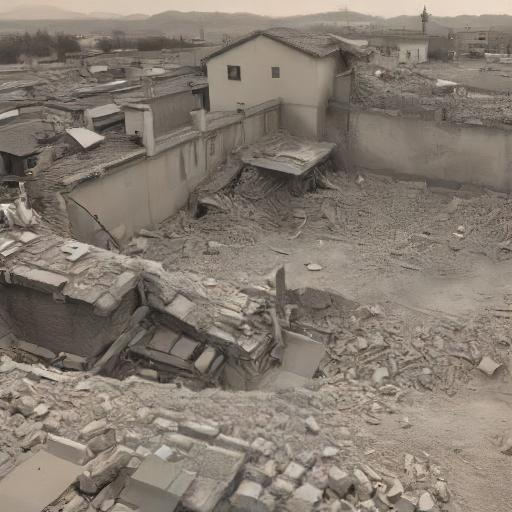Introduction
Earthquakes are among the most formidable natural disasters, characterized by sudden and violent ground shaking. They can cause widespread devastation, significant loss of life, economic hardship, and long-term societal impacts. Throughout history, earthquakes have repeatedly demonstrated their power, shaping the development and resilience of human societies. This comprehensive analysis delves into the multifaceted nature of earthquakes, from their geological origins to their catastrophic impacts on human life and infrastructure.
Understanding Earthquakes
What is an Earthquake?
An earthquake is a natural phenomenon that occurs when a sudden release of energy in the Earth’s crust creates seismic waves. This energy release is usually caused by the movement of tectonic plates, which are massive sections of the Earth’s lithosphere. The point within the Earth where the earthquake starts is called the hypocenter, and the location directly above it on the surface is known as the epicentre.
Causes of Earthquakes
Due to the dynamic nature of the Earth’s crust, tectonic forces primarily cause earthquakes. The Earth’s lithosphere is divided into several large and small tectonic plates that are constantly moving, albeit slowly. The movement of these plates can cause them to collide, pull apart, or slide against each other, leading to stress accumulation. When the stress exceeds the strength of rocks, it is released as an earthquake. Other causes include volcanic activity, human activities such as mining and reservoir-induced seismicity, and fault slippage.
Types of Earthquakes
- Tectonic Earthquakes: These are the most common and are caused by the movement of tectonic plates.
- Volcanic Earthquakes: Triggered by volcanic activity, these occur when magma forces its way to the surface.
- Induced Earthquakes: Result from human activities such as mining, reservoir-induced seismicity due to large dams, and geothermal energy extraction.
- Collapse Earthquakes: Caused by the collapse of large caves or mines.
Historical Context of Earthquakes
Ancient Accounts
Historical records and archaeological findings indicate that ancient civilizations experienced and recorded earthquake events. For instance, the Chinese historically kept detailed records of seismic activity, providing insights into early understandings of earthquakes. The destruction of ancient cities such as Pompeii (AD 79) by volcanic-induced seismic activity also underscores the historical prevalence of earthquakes.
Significant Earthquakes in History
- The 1556 Shaanxi Earthquake: The deadliest earthquake struck the Shaanxi province in China, killing an estimated 830,000 people.
- The 1906 San Francisco Earthquake: A powerful quake that caused widespread destruction in San Francisco and surrounding areas, leading to significant advancements in seismology.
- The 2004 Indian Ocean Earthquake and Tsunami Triggered a massive tsunami, affecting multiple countries and resulting in over 230,000 deaths.
- The 2010 Haiti Earthquake: A devastating earthquake that struck near Port-au-Prince, causing extensive casualties and damage.
Impact on Human Lives
Casualties and Injuries
Earthquakes can result in many casualties and injuries, often due to collapsing buildings, falling debris, and secondary hazards like fires. The immediate aftermath can overwhelm medical facilities, leading to additional deaths and complications.
Psychological Effects
The trauma of experiencing an earthquake can have long-lasting psychological effects on survivors, including post-traumatic stress disorder (PTSD), anxiety, and depression. The loss of loved ones, homes, and livelihoods exacerbates these mental health challenges.
Social Displacement
Earthquakes can lead to significant social displacement, as people are forced to leave their homes due to structural damage, lack of utilities, or fear of aftershocks. Displaced populations often face challenges in finding shelter, accessing resources, and rebuilding their lives.
Economic and Structural Damages
Infrastructure Destruction
The destructive power of earthquakes can level entire cities, demolishing buildings, roads, bridges, and utilities. The loss of infrastructure hampers rescue and relief efforts, complicating the immediate response and recovery processes.
Economic Losses
The economic impact of an earthquake extends beyond the immediate destruction. Rebuilding efforts, business loss, and trade disruptions can result in substantial financial losses. Insurance claims often soar, and the cost of reconstruction can strain national economies.
Long-term Economic Impacts
Long-term economic impacts include reduced productivity, loss of tourism, and decreased investment. The overall financial stability of affected regions can be compromised, leading to prolonged periods of economic hardship.
Case Studies of Major Earthquakes
The 1556 Shaanxi Earthquake
The 1556 Shaanxi earthquake, also known as the Jiajing earthquake, struck China’s Shaanxi province on January 23, 1556. With an estimated magnitude of 8.0, it remains the deadliest earthquake on record, claiming approximately 830,000 lives. The earthquake caused massive landslides, cave collapses, and infrastructure destruction. The high death toll was exacerbated by the densely populated region and the prevalent practice of cave dwelling in loess cliffs, which collapsed during the quake.
The 1906 San Francisco Earthquake
On April 18, 1906, a magnitude 7.9 earthquake struck San Francisco, California. The quake and subsequent fires caused widespread destruction, leaving more than 3,000 people dead and over 80% of the city in ruins. The disaster highlighted the need for improved building codes and urban planning. The scientific community’s response to this earthquake significantly advanced the field of seismology and understanding of the San Andreas Fault.
The 2004 Indian Ocean Earthquake and Tsunami
The 2004 Indian Ocean earthquake, with a magnitude of 9.1-9.3, occurred on December 26, 2004, off the west coast of northern Sumatra, Indonesia. It generated a series of devastating tsunamis that affected 14 countries, killing an estimated 230,000-280,000 people. The disaster prompted a global humanitarian response and led to the establishment of the Indian Ocean Tsunami Warning System.
The 2010 Haiti Earthquake
On January 12, 2010, a magnitude 7.0 earthquake struck near Port-au-Prince, Haiti. The earthquake caused catastrophic damage, particularly to the capital city, resulting in an estimated 230,000 deaths, 300,000 injuries, and 1.5 million people displaced. The earthquake underscored the vulnerabilities of impoverished nations to natural disasters and highlighted the importance of international aid and sustainable reconstruction efforts.
Modern Understanding and Advances in Earthquake Science
Seismology
Seismology, the scientific study of earthquakes and seismic waves, has advanced significantly over the past century. Modern seismologists use various tools, including seismographs, GPS, and satellite data, to monitor and analyze seismic activity. These advancements have improved our understanding of the Earth’s interior and the dynamics of tectonic plate movements.
Earthquake Prediction and Early Warning Systems
Predicting earthquakes with precise accuracy remains a challenge. However, early warning systems have been developed to provide seconds to minutes of advance notice. These systems use real-time seismograph data to detect the initial, less destructive waves (P-waves) that precede the more damaging waves (S-waves and surface waves). Early warning systems can help mitigate damage by allowing people to take protective actions.
Engineering and Construction Advances
Advances in engineering and construction have significantly improved the resilience of buildings and infrastructure to earthquake damage. Techniques such as base isolation, use of flexible materials, and reinforcement of structures have been developed to withstand seismic forces. Building codes and standards have also been updated to ensure new constructions are earthquake-resistant.
Mitigation and Preparedness
Building Codes and Standards
Implementing stringent building codes and standards is crucial for reducing earthquake damage. These regulations ensure that structures are designed and constructed to withstand seismic forces. Retrofitting older buildings to meet current standards is also essential to earthquake preparedness.
Emergency Preparedness Plans
Emergency preparedness plans are essential for minimizing the impact of earthquakes. These plans include public education campaigns, drills, and establishing emergency response protocols. Communities and individuals are encouraged to have emergency kits, know evacuation routes, and have communication plans.
Community Awareness and Education
Raising community awareness and educating the public about earthquake risks and preparedness measures are vital to disaster mitigation. Public education campaigns can inform people about the steps to protect themselves before, during, and after an earthquake.
Global Efforts and Policies
International Cooperation
International cooperation plays a significant role in earthquake preparedness and response. Organizations such as the United Nations, the International Federation of Red Cross and Red Crescent Societies, and various non-governmental organizations work together to provide aid and support to earthquake-affected regions.
Policy Development
Effective policies must be developed and implemented to reduce earthquake risk. Governments and international bodies must collaborate to establish guidelines and regulations that promote seismic resilience and ensure that resources are allocated effectively.
Funding and Resource Allocation
Adequate funding and resource allocation are critical for effective earthquake mitigation and response. Investments in research, infrastructure improvement, and emergency preparedness can significantly reduce the impact of earthquakes. International aid and development programs can also provide much-needed support to vulnerable regions.
Conclusion
Earthquakes are a powerful reminder of the Earth’s dynamic nature and human societies’ vulnerability to natural forces. Understanding the causes and effects of earthquakes and implementing effective mitigation and preparedness measures is crucial for reducing their impact. We can work towards a more resilient future through advancements in science, engineering, and international cooperation. As we continue to learn from past events and develop new technologies, our ability to predict, prepare for, and respond to earthquakes will improve, ultimately saving lives and reducing economic losses.














